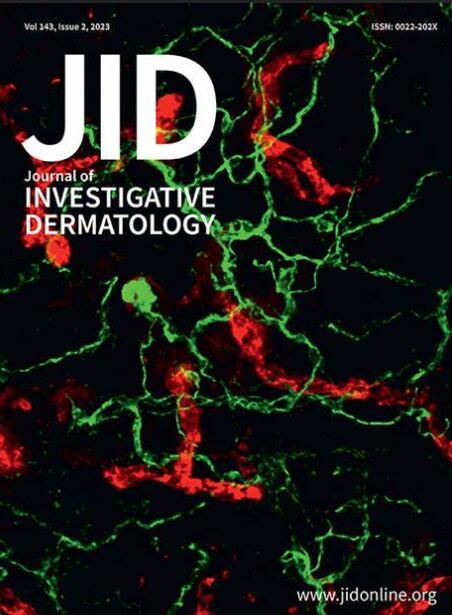经杜比鲁单抗治疗的特应性皮炎患者的浅层结膜细胞显示出牛皮癣转录组特征
IF 5.7
2区 医学
Q1 DERMATOLOGY
引用次数: 0
摘要
杜匹单抗在治疗特应性皮炎(AD)方面疗效显著。然而,一部分患者会出现眼部不良反应(OAE),包括结膜炎和干眼症,其病理机制尚不清楚。在一项双中心研究中,我们使用 DNA 微阵列分析比较了 AD 患者在开始杜比单抗治疗前(M0)和治疗 4 个月后(M4)通过印模细胞学收集的结膜细胞转录组。研究共纳入了 36 名患者,并根据他们在 M4 时的眼科状况分为两组:12 名有 OAE(OAE+),24 名无 OAE(OAE-)。分析发现,OAE+ 和 OAE- 患者在 M0 时有 52 个差异表达基因 (DEG),而在 M4 时则有 113 个差异表达基因 (DEG)。Ingenuity Pathway Analysis富集分析显示,OAE+患者在OAE结果之前和之后都有牛皮癣特征。此外,我们还注意到一些参与角质形成细胞分化的基因过度表达,尤其是编码粟粒状包膜成分的基因。在选定进行实时 RT-PCR 验证的 16 个 DEG 中,有 9 个被证实在 OAE+ 与 OAE- 患者的 M4 处上调,验证了银屑病特征,而 MUC-7 则下调。总之,这些结果表明,结膜转录组学特征使一些AD患者在接受杜匹单抗治疗后易患OAE。本文章由计算机程序翻译,如有差异,请以英文原文为准。

Superficial Conjunctival Cells from Dupilumab-Treated Patients with Atopic Dermatitis with Ocular Adverse Events Display a Transcriptomic Psoriasis Signature
Dupilumab has demonstrated efficacy in the treatment of atopic dermatitis. However, a subset of patients experiences ocular adverse events (OAEs), including conjunctivitis and dry eye syndrome, the pathological mechanisms of which are still unknown. In a bicentric study, we used DNA microarray analysis to compare the transcriptome of conjunctival cells of patients with atopic dermatitis collected by impression cytology before (M0) and 4 months after (M4) initiating dupilumab treatment. Thirty-six patients were included and divided in 2 groups according to their ophthalmological status at M4: 12 with OAEs (OAE+) and 24 without (OAE−). The analysis revealed 52 differentially expressed genes between OAE+ and OAE− patients at M0 and 113 at M4. Ingenuity Pathway Analysis enrichment revealed a psoriasis signature in OAE+ patients, both before and after OAE outcomes. In addition, we noticed the overexpression of several genes involved in keratinocyte differentiation, particularly encoding cornified envelope components. Among the 16 differentially expressed genes selected for real-time RT-PCR validation, 9 were confirmed as upregulated at M4 in OAE+ versus OAE− patients, validating the psoriasis signature, whereas MUC7 was downregulated. In conclusion, these results suggest that a conjunctival transcriptomic profile predisposes some patients with atopic dermatitis to developing OAEs upon dupilumab treatment.
求助全文
通过发布文献求助,成功后即可免费获取论文全文。
去求助
来源期刊
CiteScore
8.70
自引率
4.60%
发文量
1610
审稿时长
2 months
期刊介绍:
Journal of Investigative Dermatology (JID) publishes reports describing original research on all aspects of cutaneous biology and skin disease. Topics include biochemistry, biophysics, carcinogenesis, cell regulation, clinical research, development, embryology, epidemiology and other population-based research, extracellular matrix, genetics, immunology, melanocyte biology, microbiology, molecular and cell biology, pathology, percutaneous absorption, pharmacology, photobiology, physiology, skin structure, and wound healing

 求助内容:
求助内容: 应助结果提醒方式:
应助结果提醒方式:


